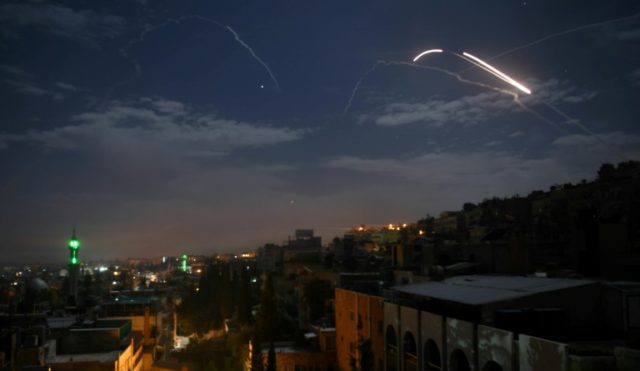TEL AVIV – Israel had been following the “killer drones” that Iran planned to use against it on Saturday night since they were flown into Syria from Tehran several weeks ago along with four members of Iran’s Islamic Revolutionary Guard Corps, the IDF said Sunday.
The plan to attack was orchestrated by the IRGC’s Quds Force commander Qassem Soleimani, the IDF chief of staff said.
The Iranian fighters intended to target northern Israel with the attack drones, each of which was packed with “several kilograms of explosives,” IDF spokesman Jonathan Conricus said earlier in the day.
The IDF monitored the Iranian plot for “a number of weeks,” Conricus said.
On Saturday around 11pm, Israel Air Force jets struck Iranian targets in the Syrian town of Aqraba, south of Damascus, thwarting an “imminent” UAV attack, the army said. According to war monitor the Syrian Observatory for Human Rights, five personnel were killed in the strikes, two of whom were operatives for the Iranian proxy terror group Hezbollah and one a member of an Iranian militia. The other two have not been identified.
“The Israeli raids targeting Iranian and Hezbollah posts … in the southeast of Damascus killed at least three people — two from Hezbollah and a third who was Iranian,” Observatory chief Rami Abdel Rahman said.
“The strike targeted Iranian Quds Force operatives and Shiite militias which were preparing to advance attack plans targeting sites in Israel from within Syria over the last number of days,” the IDF said in a statement.
In his own statement, Prime Minister Benjamin Netanyahu said: “Iran has no immunity anywhere. Our forces operate in every sector against the Iranian aggression. I have directed that our forces be prepared for any scenario. We will continue to take determined and responsible action against Iran and its proxies for the security of Israel.”
The Syrian army said that “the majority of the Israeli missiles were destroyed before reaching their targets,” but Conricus maintained that the damage caused by the Israeli strikes was “significant,” Reuters reported.
A senior official in Tehran denied that Iran’s facilities had been targeted, saying Israel didn’t have the “power” to do so.
“This is a lie and not true,” Mohsen Rezaei, who is also secretary of Iran’s Expediency Council told the semi-official ILNA news agency on Sunday, according to Reuters.
“Israel and the United States do not have the power to attack Iran’s various centers, and our [military] advisory centers have not been harmed,” Rezaei added.
Last Thursday, Israel prevented Iran from flying the attack drones into northern Israel from the Syrian village Erneh, the IDF spokesman said.
He would not elaborate on the exact method employed by the military to foil that attack, but said it was “not necessarily kinetic,” suggesting electronic warfare.
The attack drones were similar to those used by the Tehran-backed Houthi militia in Yemen, Conricus said.
“The modus operandi is similar to what we have seen in other places in the Middle East — in Yemen and Saudi Arabia,” Conricus said.
“The person who led this attack and commanded it was Qassem Soleimani personally. He funded, coached and trained Shiite operatives, who were supposed to carry it out,” IDF Chief of Staff Aviv Kochavi said at a meeting of the IDF Northern Command.
Kochavi warned that Iran may carry out retaliatory strikes but that Israel would be ready for them “in the best way possible.”
The IDF has carried out scores of strikes against Iran-linked targets in Syria, but rarely confirms specific attacks.
In February 2018, the IDF reportedly downed an armed Iranian drone that had infiltrated Israeli airspace.

COMMENTS
Please let us know if you're having issues with commenting.